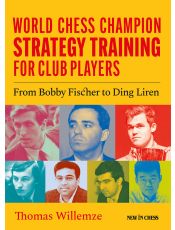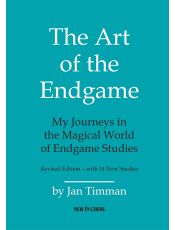
Sadler on Books (2023#8)
This book review by Matthew Sadler was published in New In Chess magazine 2023#8
I confess that when I saw the title of Jan Timman’s new book The Art of the Endgame. My Journeys in the Magical World of Endgame Studies (New In Chess) I expected this to be largely a collection of Jan’s favourite endgame studies by other composers, with a few of his own studies sprinkled into the text. I had simply no idea that Jan’s compositional output is so vast that it can fill the lion’s share of this 256-page book, nor that my jaw would drop so often to the floor in awe and wonder at what he has created during his life!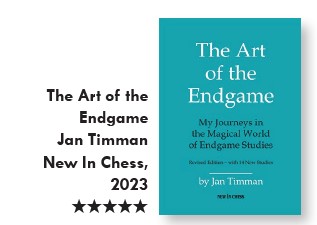 This is a revised edition of a book that first came out in 2011 but I guess I missed it at the time – very happy to have caught it the second time around! The book is divided into 14 chapters, with themes such as ‘Rook against Bishop’, ‘Knight promotions’, ‘Mutual Zugzwang’ and ‘Building a Fortress’.
This is a revised edition of a book that first came out in 2011 but I guess I missed it at the time – very happy to have caught it the second time around! The book is divided into 14 chapters, with themes such as ‘Rook against Bishop’, ‘Knight promotions’, ‘Mutual Zugzwang’ and ‘Building a Fortress’.
It’s hard to give you my favourite example from the book, as this keeps changing every time I pick it up and read it again! What I especially liked, however, was how Timman often takes you into the compositional process, explaining what inspired him and the issues he struggled with while making the study.
I also really liked the multiple expositions of the same theme in different settings. For example, this combinative sequence is well-known from the game Ortueta-Sanz, Madrid 1934: 31...♖xb2 32.♘xb2 c3 33.♖xb6 c4!! 34.♖b4 a5!! 35.♘xc4 c2 And the pawn queens!
31...♖xb2 32.♘xb2 c3 33.♖xb6 c4!! 34.♖b4 a5!! 35.♘xc4 c2 And the pawn queens!
This glorious theme has inspired many study composers, and Jan presents no less than 5(!) directly inspired by this idea. Let’s look at a couple of them!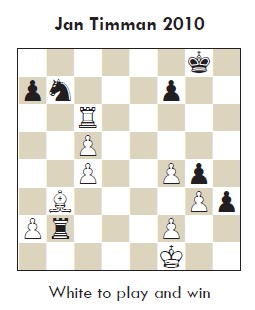 An extra twist in the position is that Black also has kingside counterplay.
An extra twist in the position is that Black also has kingside counterplay.
1.♔g1 ♖b1+ 2.♔h2 ♖b2 And now the glorious point of the study: 3.♖g6+ Intending to destroy the advanced kingside pawns with ♖xg4 and ♔xh3, so Black has no choice:
Intending to destroy the advanced kingside pawns with ♖xg4 and ♔xh3, so Black has no choice:
3...fxg6 4.c6 Thanks to 3.♖g6+, the follow-up c5 will come with check!
4...♖xb3 5.c5 ♖b5 6.a4 ♘xc5 7.c7 And wins.
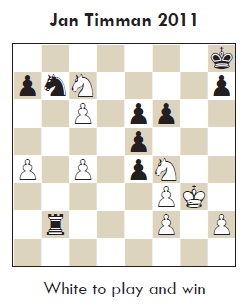 Black threatens to disrupt White by capturing on f4 with check, so that knight has to be sacrificed first.
Black threatens to disrupt White by capturing on f4 with check, so that knight has to be sacrificed first.
1.♘g6+ hxg6 2.♘b5 Now we get our theme again...but there’s an extra little twist! 2...♖xb5 3.c5 exf3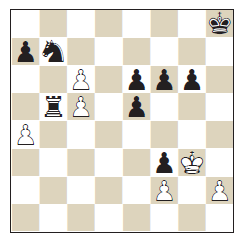 A really clever defence, as 4.axb5 ♘xc5 5.c7 ♘e4+ (the point of capturing on f3!) 6.♔xf3 ♘d6 stops the white c-pawn!
A really clever defence, as 4.axb5 ♘xc5 5.c7 ♘e4+ (the point of capturing on f3!) 6.♔xf3 ♘d6 stops the white c-pawn!
4.♔h3!! What a move! The black rook and knight are both hanging and yet White makes a quite king move to anticipate Black’s saving check on e4!
4...♘xc5 5.c7 And White wins again!
As you can imagine, I’m pretty keen on this book! A wonderful read, full of chess beauty! 5 stars!
■ ■ ■
From the easy task of loving spectacular chess back to the serious business of learning how to play, like that with Thomas Willemze’s World Chess Champion Strategy Training for Club Players (New In Chess). Thomas also writes a regular column in New In Chess magazine entitled ‘What would you play?’ spotlighting games between club players. It’s a very effective way of highlighting ideas and mistakes that are directly relevant to players of that strength, rather than focusing on the errors of top class players, as most of us do!
In this book, however, Thomas takes a different approach, highlighting instructive moments from the games of seven World Champions, from Bobby Fischer to Ding Liren, and drawing simple, actionable conclusions from each of them.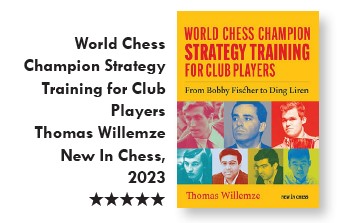
Each chapter starts with a short introduction, highlighting the salient facets of each World Champion’s style before moving onto a series of 15 exer-cises. Each chapter is rounded off with a page of flashcards to reinforce lessons learnt. I think that the value of such a book for club players depends almost entirely on the quality of the conclusions drawn from the exercises and the way in which they are conveyed, and I really like the way that Willemze does this. In particular, there are a couple of running themes throughout the exercises – occupying and invading through own files, and exchanging the right pieces – that lend the whole book a pleasing coherence and consistency as well as being extremely instructive.
I don’t want to ruin any of the exercises, so let me take an example from the introduction to Kramnik’s chapter.
I hadn’t seen this game before, but it’s a striking example of putting your pawn chain on the right colour, and fixing the opponent’s pawn structure on the wrong one!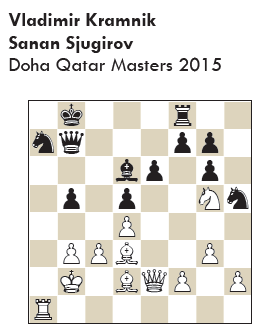 The first move is easy: White fixes the black b-pawn on a light square, making it a permanent target for the white queen and bishop battery on the f1-a6 diagonal.
The first move is easy: White fixes the black b-pawn on a light square, making it a permanent target for the white queen and bishop battery on the f1-a6 diagonal.
33.b4 ♘f6 34.♖a5 ♗c7 35.♗f4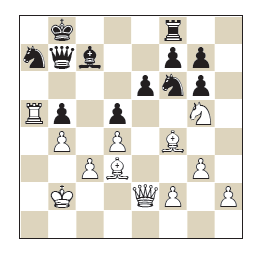 This move is really nice. It secures the win of the b5-pawn but also helps to fix all of Black’s kingside pawns on light squares as well.
This move is really nice. It secures the win of the b5-pawn but also helps to fix all of Black’s kingside pawns on light squares as well.
35...♗xf4 36.gxf4 ♕c7 37.♗xb5 ♕xf4 38.♘f3 ♘e4 39.♘e5 ♖h8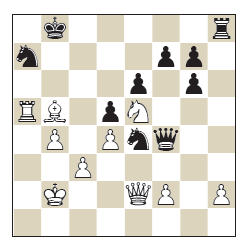 40.♘c6+ An example of the use of exchanges, that runs as a theme throughout the book. Here the excellently-placed white knight on e5 is exchanged to remove a defender of the black king and open a path for the white queen into the queenside.
40.♘c6+ An example of the use of exchanges, that runs as a theme throughout the book. Here the excellently-placed white knight on e5 is exchanged to remove a defender of the black king and open a path for the white queen into the queenside.
40...♘xc6 41.♗xc6 ♘xc3 42.♔xc3 ♖h3+ 43.♔c2 ♕xd4 44.♕b5+ ♔c7 45.♕b7+ ♔d6 46.♕b8+ ♔e7 47.♕a7+ ♕xa7 48.♖xa7+ ♔d6 49.♗a4 ♖h4 50.♔b3 ♖h3+ 51.♔b2 ♖h4 52.♖d7+ ♔e5 53.♔a3 ♔d4 54.♖xf7 ♖xh2 55.b5 ♔c5 56.♖c7+ 1-0.
A really nice book that balances quality of instruction and simplicity very well indeed. It’s somewhere between 4 and 5 stars for me, but let’s chase away winter depression with 5 bright shining stars! ■


